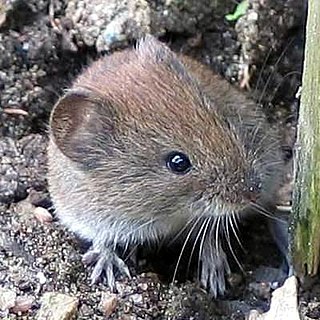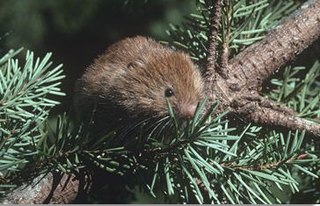Red-backed vole can refer to members of the following genera, formerly in the genus Myodes:
Red-backed vole can refer to members of the following genera, formerly in the genus Myodes:

Voles are small rodents that are relatives of lemmings and hamsters, but with a stouter body; a longer, hairy tail; a slightly rounder head; smaller eyes and ears; and differently formed molars. They are sometimes known as meadow mice or field mice in North America.

The Arvicolinae are a subfamily of rodents that includes the voles, lemmings, and muskrats. They are most closely related to the other subfamilies in the Cricetidae. Some authorities place the subfamily Arvicolinae in the family Muridae along with all other members of the superfamily Muroidea. Some refer to the subfamily as the Microtinae or rank the taxon as a full family, the Arvicolidae.

Clethrionomys is a genus of small, slender voles. In recent years the genus name was changed to Myodes, however a 2019 paper found that Myodes was actually a junior synonym for Lemmus, thus making it unusable. As such, Clethrionomys is re-established as the proper genus name. At the same time, several species were moved to the genus Craseomys, so members of both genera are referred to as red-backed voles.

The northern red-backed vole is a small slender vole found in Alaska, northern Canada, Scandinavia and northern Russia.

The southern red-backed vole or Gapper's red-backed vole is a small slender vole found in Canada and the northern United States. It is closely related to the western red-backed vole, which lives to the south and west of its range and which is less red with a less sharply bicolored tail.

The bank vole is a small vole with red-brown fur and some grey patches, with a tail about half as long as its body. A rodent, it lives in woodland areas and is around 100 millimetres (3.9 in) in length. The bank vole is found in much of Europe and in northwestern Asia. It is native to Great Britain but not to Ireland, where it has been accidentally introduced, and has now colonised much of the south and southwest.

The water voles are large voles in the genus Arvicola. They are found in both aquatic and dry habitat through Europe and much of northern Asia. A water vole found in Western North America was historically considered a member of this genus, but has been shown to be more closely related to members of the genus Microtus. Head and body lengths are 12–22 cm, tail lengths are 6.5–12.5 cm, and their weights are 70–250 g. The animals may exhibit indeterminate growth. They are thick-furred and have hairy fringes on their feet that improve their swimming ability.
The royal vole, also called the Korean red-backed vole, is a species of vole endemic to the Korean Peninsula. It lives underground in a burrow, emerging at night to feed on grasses, seeds and other vegetation. The International Union for Conservation of Nature has listed its conservation status as being of "least concern".

The grey red-backed vole or the grey-sided vole is a species of vole. An adult grey red-backed vole weighs 20-50 grams. This species ranges across northern Eurasia, including northern China, the northern Korean Peninsula, and the islands of Sakhalin and Hokkaidō. It is larger and longer-legged than the northern red-backed vole, which covers a similar range and it is also sympatric with the Norwegian lemming.

The red tree vole is a rodent of the Pacific Northwest, found in the US states of Oregon and California. They were formerly known as Phenacomys longicaudus and have also been called the red tree mouse.

The western red-backed vole is a species of vole in the family Cricetidae. It is found in California and Oregon in the United States and lives mainly in coniferous forest. The body color is chestnut brown, or brown mixed with a considerable quantity of black hair gradually lightening on the sides and grading into a buffy-gray belly, with an indistinct reddish stripe on the back and a bicolored tail about half as long as the head and body.
The Hokkaido red-backed vole is a species of rodent in the family Cricetidae. It is found at high altitudes on the island of Hokkaido in Japan and at lower altitudes on some smaller islands nearby. Its natural habitat is temperate forests.

Eothenomys is a genus of rodent in the family Cricetidae. It contains the following species:
The Ganzu vole, Eva's red-backed vole, Eva's vole, Gansu vole, or Taozhou vole is a species of rodent in the family Cricetidae. It is found in mountain forests in China. The IUCN has assessed it as being of "least concern".
The Yulungshan vole, Yulong Chinese vole, Yulongxuen Chinese vole, or Yulongxuen red-backed vole is a species of rodent in the family Cricetidae, endemic to Jade Dragon Snow Mountain in the Sichuan–Yunnan border region of China.
The Shansei vole is a species of rodent in the family Cricetidae. It is found only in north-central China where its habitat is forests.
The Japanese red-backed vole, Wakayama red-backed vole, or Anderson's red-backed vole is a species of rodent in the family Cricetidae. It is found only on the island of Honshu in Japan. It was first described by the British zoologist Oldfield Thomas in 1905. Thomas named it in honor of scientific collector Malcolm Playfair Anderson. The International Union for Conservation of Nature lists it as "least concern".
The Clethrionomyini are a tribe of forest voles in the subfamily Arvicolinae. This tribe was formerly known as Myodini, but when genus Myodes was deemed to be a junior synonym, the tribe was renamed. Species in this tribe are:
Imaizumi's red-backed vole is a species of vole in the family Cricetidae. It is found in Japan and was initially designated as a subspecies of the Japanese red-backed vole, with studies of cranial and molar patterns supporting this. However, genetic tests in the late 1990s provide support for the theory that C. imaizumii is indeed a separate species, and it is now considered such pending the completion of more detailed studies.